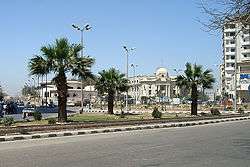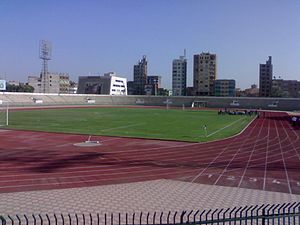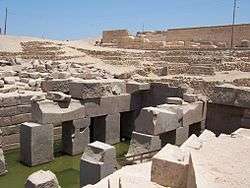Sohag
Sohag (Arabic: سوهاج [soˈhæːɡ] Sohāg, Saidi Arabic pronunciation: [suːˈhaːdʒ] Sūhāǧ), also spelled as Sawhāj, Suhag and Suhaj,[3] is a city on the west bank of the Nile in Egypt. It has been the capital of Sohag Governorate since 1960, before which the capital was Girga and the name of the governorate was Girga Governorate. It also included Esna Governorate (nowadays Qena Governorate).[4]
Sohag سوهاج | |
|---|---|
City | |
 | |
| Nickname(s): Bride of the Nile | |
 Sohag Location in Egypt | |
| Coordinates: 26°33′N 31°42′E | |
| Country | |
| Governorate | |
| Markaz | |
| Government | |
| • Governor | Dr/Aymen Abdelmonem |
| Area | |
| • City | 68 km2 (26 sq mi) |
| Elevation | 61 m (200 ft) |
| Population (2012) | |
| • City | 201,339 |
| • Rank | 20th in Egypt |
| • Density | 3,079.69/km2 (7,976.4/sq mi) |
| • Metro | 600,000 |
| Demonym(s) | Sohagi / Sohagy |
| Time zone | UTC+2 (EET) |
| Postal code | 82749[1] |
| Area code | +20 (Egypt) 93 (City)[2] |
| Website | www.sohag.gov.eg/ (in Arabic) |
History
Until the 19th century there was only a village in the area. In 1960, the capital of the Governorate of Girga was transferred from the city of Girga to Sohag and the governorate was renamed accordingly. It is unclear how long this site has been inhabited. There are several mummies that date back to Roman times in the village. In Coptic times a community of monks lived at the White Monastery in the area.
Geography

Sohag lies on a fertile agricultural plain on the western bank of the Nile,[5] approximately 6 kilometres (3.7 miles) southwest of Akhmim. The city includes two islands; Karaman-ez-Zahur Island is larger and uninhabited, and ez-Zahur Island (جزيرة الزهور, Ǧazīrat az-Zuhur, "Flower Island") has some homes.
Economy
The city Sohag of itself encloses only a few archaeological sites, hence tourism represents but a small portion of the city's income. Other sources of income include trade, small industries of carpets, furniture, spinning and weaving and sugar. Administrative and educational services are two big sectors of income.
Demographics
| 1928 | 1976 | 1986 | 1996 | 2006 | 2012 | |||
|---|---|---|---|---|---|---|---|---|
| 20,760[6] | 101,758 | 132,965 | 170,125 | 189,695 | 201,339 | |||
| Starting in 1976: Population of Sohag City[7] | ||||||||
Religion
Islam and Christianity are the main religions in Sohag; about 75% of the population are Muslim..
Historical sites
Mosques
- Sidi Arif Mosque (Arabic: مسجد العارف بالله, Masjid al-ʿArif bi-Allah). The mosque is located in the south of the city. The el-ʿArif Mosque was built in the 14th century—the 8th century of the Islamic calendar. The present building was constructed around 1995. At the corners of the façade are two minarets and the roof is crowned by a dome. Inside the five-nave mosque the bases of the piers and the walls were lined with red granite. The ceiling is painted ornamentally; in its middle is an elongated light dome. The southeastern half is lit by chandeliers. At the end are the prayer niche (mihrab) with simple ornaments and to the right of it the wooden pulpit (minbar).
 South side of the Sidi Arif Mosque |
 Inside the Sidi Arif Mosque |
 Mihrab and minbar of the Sidi Arif Mosque |
 Ceiling of the Sidi Arif Mosque |
- El-Farshuti Mosque (Arabic: جامع الفرشوطي, Jāmʿi al-Farschūṭī), also named el-'Atiq Mosque (the old mosque) is located approximately 350 metres (1,150 feet) southwest of the Sidi Arif Mosque. The most striking feature of the mosque is its 53-metre-high (174-foot) minaret in the southeast corner. The minaret has galleries with balustrades on four floors. The mosque is a modern, bright building. The mosque is divided into five naves by columns and pillars. It has a central light dome, which is inscribed at the bottom with a sura from the Qur'an. The bases of the walls are painted yellow and white with green bands. A very colorful prayer niche next to the wooden pulpit is located at the southeastern side.
In the masonry on the eastern, southern and western sides are stones engraved with historical inscriptions moved from previous buildings, including a decree of the penultimate Mamluk sultan al-Ghawri (1441–1516) from the year 1506 (911 AH) on the southeastern side.
 South side of the el-Farshuti Mosque |
 Inside the el-Farshuti Mosque |
 Mihrab and minbar of the el-Farshuti Mosque |
 Ceiling of the el-Farshuti Mosque |
Churches
Sohag has two important churches that were erected in the 20th century: the Church of the Holy Virgin and the Church of Saint George.
- The Church of the Holy Virgin (Arabic: كنيسة السيدة العذراء, Kanīsat as-Saiyida al-ʿAdraʾ). The church is located in the north of the bazaar (souq Qaiṣarīya). It consists of five naves. There are three sanctuaries for Saint George (left), the Holy Virgin and the Archangel Michael at the ends of the middle three naves. All sanctuaries are completely screened by a wooden iconostasis. On both sides of the entrances to the sanctuaries are wooden icons of the Holy Virgin and Jesus. The Lord's Last Supper and the crosses are located above the iconstasis. The presentation in the central nave is framed by a fish and a pigeon; the other ones are framed by angels and a dove. Galleries are located above the aisles and the entrance. On the walls are paintings of saints and scenes from the life of Jesus.
 Church of the Holy Virgin |
 Inside the Church of the Holy Virgin |
Icon of the Holy Virgin with her child |
- Church of St. George is the cathedral of the diocese of Sohag (Arabic: كنيسة مار جرجس, Kanīsat Mar Girgis). The church is located 300 metres (980 feet) north of the Opera (Midan Obira) or Culture Square (Midan eth-Thaqafa).
- Church of the Archangel Michael (Arabic: كنيسة الملاك ميخائيل). The church is located in Railway Station Street (El-Mahatta Street) on the eastern side of the railway tracks.
Monasteries
White Monastery
The Coptic White Monastery is a Coptic Orthodox monastery named after Saint Shenouda the Archimandrite. It is located about 5 kilometres (3.1 miles) west of Sohag. The monastery's name is derived from the color of the white limestone in its outside walls. The surviving building is the church of what was once a much larger monastery complex.[8]
Red Monastery
The Red Monastery is a Coptic Orthodox monastery named after an Egyptian saint called Pishay. It is located about 5 kilometres (3.1 miles) north of the White Monastery. The monastery's name is derived from the color of the construction material of its outside walls, consisting of red (burnt) brick. The walls are considerably thicker at the base than at the top and, like the walls of Ancient Egyptian temples, they are surmounted by cavetto moldings. The Red Monastery is architecturally similar to the White Monastery.[8]
 Red Monastery |
 White Monastery |
Temples and cemeteries
Sohag is the site of a temple built for the goddess Repyt (Triphis) by Ptolemy XV Caesarion and subsequent Roman emperors. South of this temple was an earlier temple of Ptolemy IX Soter II (see also Athribis Project). One of the nearby tombs of the brothers Ibpemeny "the younger" and Pemehyt of the late second century BC, has two zodiacs on its ceiling.[9]
Subdivisions
Sohag is informally divided into the East District (Arabic: حى شرق) and the West District (Arabic: حي غرب). Among the most notable regions of the West District are:
- Sidi Aref
- Al Shahid (Arabic for the Martyr)
- Gharb Al-Koubry ("West of the Bridge" neighborhood)
The East District is considered a more upscale district; it includes some of the most affluent neighborhoods of the city including 15th Street, Al Kashef Street, Jumhuriya Street, The Courts Compound, and The Technical and Agricultural Schools. Some of the most notable locales of the East District include:
- The Courts Compound of Sohag
- City Hall of Sohag
- Sohag University
- Sohag Teaching Hospital, one of the biggest hospitals of the region
- Multiple governmental directorates
- Many recreational areas including The Sohag Stadium and many parks including Al Zohour, a revitalized island park located in the middle of the Nile.
- Nasr City, the first satellite city to be built in the East District. It was established during the presidency of Gamal Abdel Nasser.
Climate
The Köppen-Geiger climate classification system classifies Sohag's climate as hot desert (BWh). Luxor, Minya, Sohag, Qena and Asyut have the widest difference of temperatures between days and nights of any city in Egypt, with almost 16 °C (29 °F) difference. Sohag is one of the warmest places in Egypt due to its location on the eastern side of Sahara in North Africa. Sohag is ranked the 5th driest place in Egypt and the 9th globally. Also ranked 4th warmest place in Egypt and 296th globally.
| Climate data for Sohag | |||||||||||||
|---|---|---|---|---|---|---|---|---|---|---|---|---|---|
| Month | Jan | Feb | Mar | Apr | May | Jun | Jul | Aug | Sep | Oct | Nov | Dec | Year |
| Record high °C (°F) | 30.8 (87.4) |
37.5 (99.5) |
42.2 (108.0) |
43.9 (111.0) |
47.4 (117.3) |
47.9 (118.2) |
47.0 (116.6) |
43.4 (110.1) |
44.4 (111.9) |
43.1 (109.6) |
37.0 (98.6) |
33.3 (91.9) |
47.9 (118.2) |
| Average high °C (°F) | 22.0 (71.6) |
23.8 (74.8) |
27.5 (81.5) |
33.6 (92.5) |
37.7 (99.9) |
39.6 (103.3) |
38.8 (101.8) |
37.8 (100.0) |
36.0 (96.8) |
33.7 (92.7) |
28.2 (82.8) |
23.5 (74.3) |
31.9 (89.4) |
| Daily mean °C (°F) | 13.9 (57.0) |
15.6 (60.1) |
18.9 (66.0) |
24.5 (76.1) |
29.1 (84.4) |
30.7 (87.3) |
31.0 (87.8) |
29.9 (85.8) |
27.9 (82.2) |
25.1 (77.2) |
19.8 (67.6) |
15.4 (59.7) |
23.5 (74.3) |
| Average low °C (°F) | 7.3 (45.1) |
8.8 (47.8) |
11.8 (53.2) |
16.6 (61.9) |
21.1 (70.0) |
23.1 (73.6) |
24.1 (75.4) |
23.1 (73.6) |
20.6 (69.1) |
17.8 (64.0) |
13.0 (55.4) |
9.2 (48.6) |
16.4 (61.5) |
| Record low °C (°F) | 0.4 (32.7) |
2.6 (36.7) |
3.3 (37.9) |
7.7 (45.9) |
11.5 (52.7) |
15.7 (60.3) |
17.6 (63.7) |
18.0 (64.4) |
15.9 (60.6) |
11.4 (52.5) |
4.8 (40.6) |
2.6 (36.7) |
0.4 (32.7) |
| Average precipitation mm (inches) | 0 (0) |
1 (0.0) |
0 (0) |
0 (0) |
0 (0) |
0 (0) |
0 (0) |
0 (0) |
0 (0) |
0 (0) |
0 (0) |
0 (0) |
1 (0) |
| Average precipitation days | 0.1 | 0.1 | 0.2 | 0.1 | 0 | 0 | 0 | 0 | 0 | 0 | 0 | 0.2 | 0.7 |
| Average relative humidity (%) | 57 | 50 | 44 | 36 | 30 | 31 | 37 | 43 | 45 | 44 | 51 | 56 | 43.7 |
| Source 1: NOAA[10] | |||||||||||||
| Source 2: Climate Charts[11] | |||||||||||||
Culture
Language
A version of the dialect continuum of Saidi Arabic is spoken by the people of Sohag. Most urbanized people, however, may speak to varying degrees Egyptian Arabic.
Museums
The Sohag Museum contains about 5,000 artifacts gathered from around the Sohag governorate, including items stretching from the Middle Kingdom to Greco-Roman times.[5][12]
Bazaars
Souq el-Qisareya: The bazaar in Sohag is named suq Qaiṣarīya and is partly covered.
Souq el-Itnein is a weekly market held every Monday morning; vegetables, fruits, animals and traditional hand made objects (like baskets, farming axes and bags) are sold there. The weekly market is believed to have originated during the Ancient Egyptian era. The souq is now in the south of the city and is held in the streets and beside the city cemetery.[5]
Transport

Sohag is linked to Giza and northern cities by the road of Asyut Western Desert, Eastern Desert Road and Rural Road, which also connects it to the railways.
In February 2010, a highway linking Sohag to the Red Sea city Hurghada was opened to ease movement between Upper Egypt and the Red Sea coastal region. In May 2010, the Egyptian President Hosni Mubarak inaugurated Sohag International Airport.
| City | Distance (km) |
|---|---|
| Alexandria | 692 |
| Port Said | 691 |
| Ismaïlia | 616 |
| Suez | 605 |
| Cairo | 471 |
| Aswan | 428 |
| Luxor | 205 |
| Asyut | 98 |
Education

Educational establishments in Sohag include: Primary schools:
- Al-Nasr school
- Huda Sharawi school
- Mulhaqat Al-Mu'allemat school
Middle schools:
- Ahmad Deifalla school
- Nabawi Muhandis school
- Ali Osman Baltak school
- Tarik Ibn Ziad school
High schools:
- Sohag Military school
- Abdelmunim Riad school
- Asmaa Bint Abi Bakr school
- Hag Hadad school
University
Sohag University is a public university with more than 40,000 students[13] located on the eastern side of the city. It was established under the banner of South Valley University but became independent in 2006. There are currently ten colleges in Sohag University.
Sports

The most popular sport in Sohag is Association football. Sohag has many football clubs, including the Egyptian Premier League (EPL) team Sohag FC. In addition, EPL club has El Gouna FC used Sohag stadium as a home ground at times.
Notable people
Notable people who originate from or live in Sohag include:
- Narmer, The first pharaoh of unified Egypt and the founder of the Early Dynastic Period (c. 32nd century BC).
- Sheikh Mohamed Siddiq El-Minshawi, one of the most renowned Qur'anic reciters of all the Islamic world.
- Muhammad Sayyid Tantawy, Former Imam of Al-Azhar.
- Rifa'a el-Tahtawi, writer, teacher, translator, Egyptologist, renaissance intellectual and founder of Madrasat al-Alsun (Tongues School).
- Mustafa al-Maraghi, reformer and rector of Al-Azhar Mosque.
- Mohammed Aboul-Fotouh Hassab, gastro-intestinal surgeon.
- Gamal El-Ghitani, author of historical novels and cultural and political commentaries.
- Atef El-Tayeb, film director.
- George Sidhom, film actor.
- Emad Hamdy, Film actor.
- Baligh Hamdi, composer who created hit songs for many prominent Arabic singers.
- Dhul-Nun al-Misri, Sufi saint considered the Patron Saint of the Physicians in the early Islamic era of Egypt .
- Jaber Abu Hussein, narrator of the Taghribat Bani Hilal.
- Omar Taher, writer and poet.
- Youssef Ziedan, scholar in Arabic and Islamic Studies.
Nearby attractions

- Abydos is one of the most ancient cities of Upper Egypt, and also of the eighth Upper Nome, of which it was the capital city. It is considered one of the most important archaeological sites of Ancient Egypt. The sacred city of Abydos was the site of many ancient temples, including a Umm el-Qa'ab, a royal necropolis where early pharaohs were entombed.
- Akhmim has several mosques and two Coptic churches. It maintains a weekly market and manufactures cotton goods.
- El-Hawawish is the ancient necropolis (cemetery) for Akhmim.
- El-Salamuni comprises a rock-cut chapel dedicated to the god Min.
- The Meritamen statue in eastern Akhmim.
- Outside Beit Khallaf are two large brick mastabas from the Third Dynasty.
- The city Athribis is the site of a temple built for the goddess Repyt (Triphis) by Ptolemy XV Caesarion and subsequent Roman Emperors.
Photo gallery
 Building in Sohag
Building in Sohag Roman theater
Roman theater Tahtawy memorial
Tahtawy memorial Sohag city hall
Sohag city hall Jumhuriyea St.
Jumhuriyea St. Orouba sq.
Orouba sq.- Skyline.
 Jazirat Al Zohour .
Jazirat Al Zohour . Nile view (east bank)
Nile view (east bank) Courts compound
Courts compound Downtown
Downtown Nile view from Akhmim bridge
Nile view from Akhmim bridge
References
- "Egypt Postal Code". Egypt-cairo.com. Retrieved 15 October 2017.
- Prozzone. "Sohag, EGYPT :: city code, std code, dial code, country code, long distance". www.prozzone.com. Retrieved 15 October 2017.
- "World Gazetteer: Sohag - profile of geographical entity including nam…". 16 December 2012. Retrieved 15 October 2017.
- Law, Gwillim (1999). Administrative Subdivisions of Countries: A Comprehensive World Reference, 1900 through 1998 (snippet view). Jefferson, NC: McFarland. p. 114. ISBN 978-0-7864-0729-3. Retrieved 2010-08-07.
- Richardson, Dan (2003). The Rough Guide to Egypt. pp. 322–323. ISBN 1-84353-050-3.
- Baedeker, Karl ; Steindorff, Georg : Ägypten und der Sûdan : Handbuch für Reisende, Leipzig: Baedeker, 1928, 8. ed., p. 221.
- "World Gazetteer: Sohag". Archived from the original on 16 December 2012.
- Haag, Michael (2004). Egypt. New Holland Publishers. pp. 222–226. ISBN 1-86011-163-7.
- Richard Talbert, Barrington Atlas of the Greek and Roman World, (ISBN 0-691-03169-X), p. 77.
- "Sohag Climate Normals 1961–1990". National Oceanic and Atmospheric Administration. Retrieved January 17, 2016.
- "Sohag, Egypt: Climate, Global Warming, and Daylight Charts and Data". Climate Charts. Retrieved 9 July 2013.
- "The Sohag Museum". Supreme Council of Antiquities - Museums. Retrieved December 14, 2016.
- "جامعة سوهاج". Sohag-univ.edu.eg. Retrieved 15 October 2017.
External links
| Wikimedia Commons has media related to Sohag. |
- (in German) Sohag on Wikivoyage
- Sohag on Travel grove
- Sohag photo album